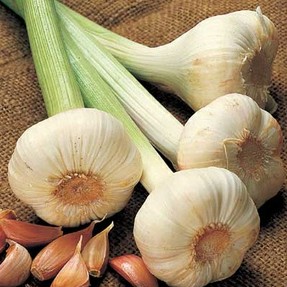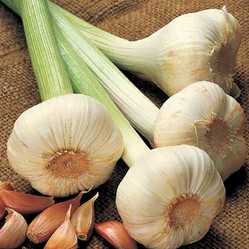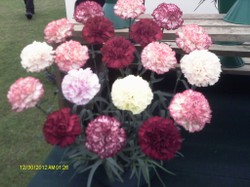Growing garlic has become a hobby for many people in the United States and elsewhere due to its popularity as a medicinal plant, and as a seasoning for food. As garlic continues to grow in popularity, more and more local farmers are also including garlic in their plant mix, as well as producing garlic flavored products like garlic jelly, and pickled garlic.

Growing Garlic
As fresh local food becomes more popular, many people are growing their own vegetables and herbs. Growing garlic is easy in many climates, and can be used in a variety of recipes.
Garlic Has Been Grown For Centuries as a Food Additive, and a Medicinal Plant

Garlic festivals are springing up in parts of the world, and with the trend in foods moving more towards local, fresh, and organic, garlic continues to be one of the foods that is purchased locally by residents wherever it can be grown.
Fresh garlic has been known to be used for many purposes, including as an antibiotic in ancient times, a digestive ailment, and an insect repellent. It also blends extremely well with many foods including meats, vegetables, and breads, and can also be used as a spread when roasted.
How to Grow Garlic
Garlic can be grown in the ground or in containers
The best way to purchase garlic to grow is in the bulb form. Garlic can be grown year round in mild climates or will come up as a perennial in harsher climates. One of the advantages of growing garlic in areas where deer, rabbits, or other plant eating animals live, is that they do not like the taste of the garlic plant, therefore you do not need to fence in that area of your garden.
In cold climates, climates that have a true winter season, garlic should be planted in the fall, about 6 weeks before the ground will freeze. Garlic will grow under a wide variety of soil conditions.
Shortly before planting break the bulbs apart into cloves. When you break apart the bulb, each clove should break away intact. Plant the the cloves just far enough apart to allow the bulbs to grow, about 3 to 4 inches. Garlic bulbs will grow underground, while the stems will grow above ground. It is important to plant garlic with the top of the clove up, two inches below the surface.
Some garlic varieties produce a central stalk which goes straight up and then usually makes one or two loops. The garlic top is called a scape. If you want the garlic plant to produce a large bulb, snip the scape off after it has made one or two loops.
Garlic requires fairly even soil moisture during the growing season with no additional moisture during the last few weeks. Garlic plants are extremely hardy, which makes them a good plant for harsher climates, and for beginner gardeners. They are ready to harvest in the late spring.
Have You Ever Tried Growing Garlic at Home?
Or do you prefer to buy it
Harvesting Garlic
To determine whether the garlic is ready to harvest, you need to manually check a few bulbs in the ground. Use your fingers to feel the cloves through the ground to see if the bulb is fully developed. If the garlic feels right, it is ready to harvest.
Once it is ready, pull the garlic out from the ground to store, cook, or eat.
Garlic Varieties
We are often only exposed to one variety of garlic in the grocery store.
Garlic comes in several varieties, but they are all classified under the scientific name: Allium Sativum. The most closely related plants are onions, and shallots. Garlics are divided into two sub-categories, hard-necked and soft-necked garlics.
Hard-Necked Garlic Varieties
- Porcelain--Porcelain garlic has bulb wrappers that tend to be thick and parchment-like. Porcelains are generally strong tasting.
- Rocambole--Rocambole garlic has thinner bulb wrappers and is flavorful, and hot.
- Purple Stripe--Purple Stripe garlic has purplish vertical stripes decorating the bulb wrappers. They are rich in flavor, but not overly pungent.
Soft-Necked Garlic Varieties
- Artichoke--Artichoke garlic is the garlic most often sold commercially. It generally has between 12 to 20 cloves per bulb.
- Silverskin--Silverskin garlic is strong flavored with white bulb wrappers.
- Creole--Creole garlic is often eaten raw due to its rich, full taste. Bulb wrappers are a rose color.
- Asiatic--Asiatic garlic has white bulb wrappers which can be thick and parchment-like with straw-colored clove covers.
Learn More About Garlic
 |  |  |
| Garlic and the Vampire: A Graphic Novel Quill Tree Books | The Garlic Companion: Recipes, Crafts... Storey Publishing, LLC | Garlic and Sapphires: The Secret Life... Penguin Books |
 |  |  |
| Garlic and the Witch Quill Tree Books | Garlic, Olive Oil + Everything Medite... S&S/Simon Element | Garlic: Nature's Original Remedy Healing Arts Press |
You might also like
A Flower Show, a gold medal and a mini-tornadoMembers day at the Tatton Flower Show was a lovely experience.
A day in a Floral MarqueeI spent a day working on the National Vegetable Society stall at the Tattton ...



 Best Father-to-be Bookson 06/04/2013
Best Father-to-be Bookson 06/04/2013
 Gothic Garden - Black Flowerson 05/20/2011
Gothic Garden - Black Flowerson 05/20/2011
 Leatherwork: The Art of Working with Leatheron 03/14/2013
Leatherwork: The Art of Working with Leatheron 03/14/2013
 Contemporary Desk Lamps for Home or Officeon 08/29/2012
Contemporary Desk Lamps for Home or Officeon 08/29/2012


Comments
I would like to try growing garlic. We recently visited an amazing garlic farm and got to try lots of varieties. I came home with a renewed love of garlic. I've featured this page on my roasted garlic recipe wizzle.
I grew garlic over the winter and just pulled up the very small bulbs since I will be moving soon. I plan to try growing it again because I use garlic all the time in my cooking and salads.
Garlic is a good plant to start gardening with if you are a new gardener, because they do not take a lot of work. So if you are a first time gardener, do not be afraid to try garlic.
I haven't really given garlic a fair trial. I am planning to plant some again though shortly.
Nothing tastes better then fresh garlic! I have always bought from local farms, but I might just try to grow it in my veggie garden this year.
I grow a lot of herbs in my garden, but I have never tried growing garlic - I think it is time to try.
This is from Wikipedia
Elephant garlic (Allium ampeloprasum var. ampeloprasum) is a plant belonging to the onion genus. It is not a true garlic, but actually a variant of the species to which the garden leek belongs. It has a tall, solid, flowering stalk and broad, flat leaves much like those of the leek, but forms a bulb consisting of very large, garlic-like cloves. The flavor of these, while not exactly like garlic, is much more similar to garlic than to leeks. The flavor is milder than garlic, and much more palatable to some people than garlic when used raw as in salads.
A friend of mine bought something called elephant garlic. It is a giant garlic, so so big. However it is not as strong as the regular ones. Have you ever heard of that?
Excellent article Paula, I am growing garlic in containers now, but mine is a spring planted variety that should be ready to harvest later this year (August/September time). This is only my second attempt at garlic, so I will be interested to see if I improve on my last (rather poor) effort :)
I planted a couple of cloves last year - the stalks grew up but then they died - I left the pot outside and ignored it and now there are some fresh stalks - thanks for the extra info - maybe it'll work out this time :)